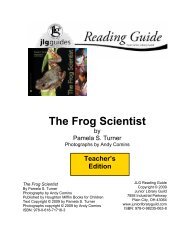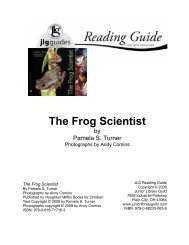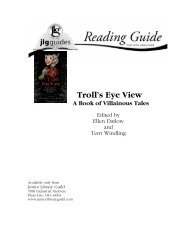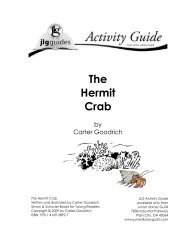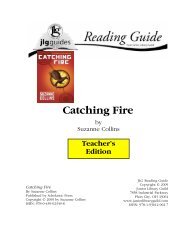Catching Fire SE JLGGuide - Junior Library Guild
Catching Fire SE JLGGuide - Junior Library Guild
Catching Fire SE JLGGuide - Junior Library Guild
Create successful ePaper yourself
Turn your PDF publications into a flip-book with our unique Google optimized e-Paper software.
<strong>Catching</strong> <strong>Fire</strong><br />
by<br />
Suzanne Collins<br />
<strong>Catching</strong> <strong>Fire</strong><br />
By Suzanne Collins<br />
Published by Scholastic Press<br />
Copyright © 2009 by Suzanne Collins<br />
ISBN: 978-0-439-02349-8<br />
JLG Reading Guide<br />
Copyright © 2009<br />
<strong>Junior</strong> <strong>Library</strong> <strong>Guild</strong><br />
7858 Industrial Parkway<br />
Plain City, OH 43064<br />
www.juniorlibraryguild.com<br />
ISBN: 978-1-93612-902-7<br />
Copyright © 2009 <strong>Junior</strong> <strong>Library</strong> <strong>Guild</strong>/Media Source, Inc. 0
About JLG Guides<br />
<strong>Junior</strong> <strong>Library</strong> <strong>Guild</strong> selects the best new hardcover children’s and YA<br />
books being published in the U.S. and makes them available to libraries and<br />
schools, often before the books are available from anyone else. Timeliness<br />
and value mark the mission of JLG: to be the librarian’s partner. But how<br />
can JLG help librarians be partners with classroom teachers?<br />
With JLG Guides.<br />
JLG Guides are activity and reading guides written by people with<br />
experience in both children’s and educational publishing—in fact, many of<br />
them are former librarians or teachers. The JLG Guides are made up of<br />
activity guides for younger readers (grades K–3) and reading guides for<br />
older readers (grades 4–12), with some overlap occurring in grades 3 and 4.<br />
All guides are written with national and state standards as guidelines.<br />
Activity guides focus on providing activities that support specific reading<br />
standards; reading guides support various standards (reading, language arts,<br />
social studies, science, etc.), depending on the genre and topic of the book<br />
itself.<br />
JLG Guides can be used both for whole class instruction and for<br />
individual students. Pages are reproducible for classroom use only, and a<br />
teacher’s edition accompanies most JLG Guides.<br />
Research indicates that using authentic literature in the classroom<br />
helps improve students’ interest level and reading skills. You can trust JLG<br />
to provide the very best in new-release books, and now to enhance those<br />
selections by giving your school the tools to use those books in the<br />
classroom.<br />
And in case you think we forgot the librarians, be sure to check out<br />
the <strong>Library</strong> Applications page, shown on the table of contents in each<br />
guide.<br />
From all of us at <strong>Junior</strong> <strong>Library</strong> <strong>Guild</strong>, we wish you and your students<br />
good reading and great learning . . . with JLG Selections and JG Guides.<br />
Copyright © 2009 <strong>Junior</strong> <strong>Library</strong> <strong>Guild</strong>/Media Source, Inc. 1
<strong>Catching</strong> <strong>Fire</strong><br />
by Suzanne Collins<br />
JLG Guide written by Sarah Ward Terrell<br />
Table of Contents<br />
About the Author .......................................................................................................3<br />
Prereading Activities..................................................................................................4<br />
Through the Chapters<br />
Chapters 1–4.........................................................................................................7<br />
Chapters 5–7.......................................................................................................12<br />
Chapters 8–9.......................................................................................................16<br />
Chapters 10–13...................................................................................................20<br />
Chapters 14–16...................................................................................................23<br />
Chapters 17–18...................................................................................................26<br />
Chapters 19–21...................................................................................................30<br />
Chapters 22–24...................................................................................................33<br />
Chapters 25–27...................................................................................................35<br />
Wrap Up ....................................................................................................................38<br />
<strong>Library</strong> Applications.................................................................................................40<br />
Suggestions for Further Reading ...........................................................................41<br />
Correlations to National Standards .......................................................................42<br />
A school may reproduce copies of the pages in this book for use in its<br />
classrooms or library. Any other reproduction is strictly prohibited.<br />
All rights reserved. No part of this publication may be transmitted, stored, or recorded in any form<br />
without written permission from the publisher. For permissions questions, contact <strong>Junior</strong> <strong>Library</strong> <strong>Guild</strong>.<br />
Copyright © 2009 <strong>Junior</strong> <strong>Library</strong> <strong>Guild</strong>/Media Source, Inc. 2
About the Author<br />
Before becoming a writer of novels, Suzanne Collins was an adult playwright and a<br />
writer for a number of critically acclaimed children’s television shows. Since then she<br />
has written a popular fantasy book series for middle-graders, entitled The Overland<br />
Chronicles, as well as the children’s picture book, When Charlie McButton Lost Power,<br />
illustrated by Mike Lester.<br />
Ms. Collins’s most recent series is a fictional trilogy that is nearing completion.<br />
The Hunger Games was the first title in the series, and <strong>Catching</strong> <strong>Fire</strong> is the second.<br />
Both are about a girl named Katniss who lives in the futuristic country of Panem.<br />
The author’s inspiration for this series is rooted in Greek mythology and ancient<br />
Roman history. Says Ms. Collins in an interview released by her publisher,<br />
In keeping with my classical roots, I send my tributes into an<br />
updated version of the Roman gladiator games, which entails a<br />
ruthless government forcing people to fight to the death as popular<br />
entertainment. The world of Panem, particularly in the Capitol, is<br />
loaded with Roman references. Panem itself comes from the<br />
expression “Panem et Circenes,” which translates to “Bread and<br />
Circuses.”<br />
The audiences for both the Roman games and reality TV are<br />
almost characters in themselves. They can respond with great<br />
enthusiasm or play a role in your elimination.<br />
The Hunger Games series is considered dystopic fiction, a type of fiction that<br />
features a world in which people live in miserable conditions and that often involves<br />
war, oppression, violence, suffering, lack of freedom, and poverty. Though these<br />
issues are tough, Ms. Collins thinks many young adults are able to handle the concepts<br />
presented in her books. Her hope is that readers will come away from The Hunger<br />
Games and <strong>Catching</strong> <strong>Fire</strong> with “questions about how the elements of the book relate to<br />
their own lives—and, if they’re disturbing, what they will do about them.”<br />
Sources<br />
Collins, Susan. “Biography.” Web. 30 August 2009.<br />
<br />
Everett, Sheila Maria.” A Conversation: Questions and<br />
Answers: Suzanne Collins, Author of The Hunger<br />
Games.” Scholastic, Inc.<br />
Copyright © 2009 <strong>Junior</strong> <strong>Library</strong> <strong>Guild</strong>/Media Source, Inc. 3
Prereading Activities<br />
Book Summary<br />
<strong>Catching</strong> <strong>Fire</strong>, by Suzanne Collins, is the second in a series of books that starts with<br />
The Hunger Games. Both books take place in North America after a long string of<br />
natural disasters. Encroaching ocean tides have changed the face of the continent, and<br />
wars have led to political restructuring of the region. Where once there were Mexico,<br />
the United States, and Canada, now there is a new country called Panem.<br />
The ruling elite of Panem live luxuriously in the Capitol, a city west of the<br />
Rocky Mountains, while Panem’s other inhabitants struggle to exist in the Capitol’s<br />
thirteen surrounding districts. Citizens in Districts 1 through 12 live in service to the<br />
Capitol, and those in District 13 are believed to have been wiped out, because they<br />
rebelled against Panem’s government.<br />
Life in the districts is focused purely on survival. Each district has a specific<br />
industry that makes it useful to the Capitol, and the livelihood of the district’s people<br />
depends on their ability to work in that industry. Citizens have little knowledge of<br />
what goes on in neighboring districts, and cruelly enforced laws ensure their<br />
dependence on the Capitol for food and supplies.<br />
The Hunger Games is the story of Katniss, a sixteen-year-old girl who lives in<br />
District 12. In this district, once called Appalachia and now nicknamed “The Seam,”<br />
coal mining is the industry. However, Katniss makes her living as an outlaw. She<br />
provides for her family by hunting wild game outside district boundaries and selling it<br />
on the Black Market—that is, until she’s caught up in the Capitol’s most insidious<br />
strategy for terrorizing the districts.<br />
Every year, the Capitol forces districts to participate in a televised event called<br />
The Hunger Games. The Games commemorate the Dark Days, a period of rebellion<br />
that ended with the destruction of District 13. They celebrate the Capitol’s complete<br />
control over the districts, and they continue a punishment that has been passed down<br />
for seventy-four years. Each district must provide two tributes, one boy and one girl, to<br />
fight to the death in an arena match. Out of twenty-four tributes, only one survives.<br />
Tributes for the Hunger Games are determined through a drawing of names,<br />
called The Reaping. But Katniss becomes a tribute by volunteering; she takes her<br />
sister’s place when her sister’s name is drawn. Katniss competes in the Games<br />
alongside Peeta, the male tribute from her district. The two become the first joint<br />
victors in the Games, when a concocted budding romance between them captures the<br />
hearts of some viewers in the Capitol. Katniss and Peeta make a suicide pact, so they<br />
won’t have to fight each other, and Game organizers are forced to declare them both<br />
winners to avoid audience disapproval.<br />
<strong>Catching</strong> <strong>Fire</strong> picks up where The Hunger Games left off. Katniss’s victory in the<br />
arena has made her a celebrity, but this carries a tremendous weight. She’s sickened by<br />
what she had to do to stay alive, and she’s isolated from the people she loves most.<br />
What is more, she has angered Capitol officials, who suspect her suicide pact with<br />
Peeta was merely a stunt to make the government look bad—which is probably<br />
accurate. Even Katniss is unsure whether love or strategy played a bigger part in her<br />
relationship with Peeta during the Games. Now forced to live her life on camera,<br />
Katniss may never be allowed to sort out her true feelings for Peeta—or for Gale, the<br />
boy she left behind when she became a tribute. Even worse, she fears the government<br />
will punish her by harming her friends and family. How will she be able to keep<br />
everyone safe while trapped in the public eye?<br />
Copyright © 2009 <strong>Junior</strong> <strong>Library</strong> <strong>Guild</strong>/Media Source, Inc. 4
Understanding Genre: Dystopian Fiction<br />
Yu will probably need to do some research to find out about this genre, which is also<br />
known as speculative fiction. The Internet may be helpful.<br />
1. What are the characteristics of dystopian fiction?<br />
2. Reread the <strong>Catching</strong> <strong>Fire</strong> book summary. Why is <strong>Catching</strong> <strong>Fire</strong> an example of<br />
dystopian fiction?<br />
3. Though this story takes place in the future, the culture it describes is not completely<br />
different from ours. How is it similar?<br />
4. How might dystopian fiction be an effective format for commenting on current<br />
issues?<br />
Copyright © 2009 <strong>Junior</strong> <strong>Library</strong> <strong>Guild</strong>/Media Source, Inc. 5
Prereading Activities<br />
Making Predictions<br />
Reread the Book Summary for <strong>Catching</strong> <strong>Fire</strong>. Then make predictions<br />
based on evidence from the text and/or from your prior knowledge<br />
or personal experience.<br />
1. Do you think Katniss will be able to keep her friends and family safe from<br />
Panem’s government?<br />
I predict:<br />
Based on what evidence?<br />
2. Think about the title, <strong>Catching</strong> <strong>Fire</strong>. What do you think “catching fire” has to do<br />
with what the story is about?<br />
I predict:<br />
Based on what evidence?<br />
3. Set a purpose for reading based on your predictions above.<br />
Copyright © 2009 <strong>Junior</strong> <strong>Library</strong> <strong>Guild</strong>/Media Source, Inc. 6
Chapters 1–4<br />
Dissent Is in the Air<br />
pages 3–62<br />
Before You Read<br />
Introducing Vocabulary: Greek and Latin Roots<br />
A root word is the basic part of a word that has meaning. Prefixes and suffixes are<br />
sometimes added to the root word to adapt the meaning in some way. Each of the<br />
following vocabulary words contains a root word from the Greek or Latin language.<br />
Find two other words containing the same root. Choose Word 1 from the box below<br />
and find Word 2 using a dictionary, a word-origins book, or the Internet. Then write<br />
their shared root word, along with its meaning, on the line provided.<br />
solely dynamite approximate<br />
mental phobia renege<br />
1. claustrophobic Word 1: Word 2:<br />
Root Word and Meaning:<br />
2. mentor Word 1: Word 2:<br />
Root Word and Meaning:<br />
3. proximity Word 1: Word 2:<br />
Root Word and Meaning:<br />
4. dynamic Word 1: Word 2:<br />
Root Word and Meaning:<br />
5. solitude Word 1: Word 2:<br />
Root Word and Meaning:<br />
6. negate Word 1: Word 2:<br />
Root Word and Meaning:<br />
Copyright © 2009 <strong>Junior</strong> <strong>Library</strong> <strong>Guild</strong>/Media Source, Inc. 7
After You Read<br />
Checking Predictions<br />
Before reading, you made a prediction about how the title <strong>Catching</strong> <strong>Fire</strong> relates to<br />
what the story is about. Based on what you have read so far, is your prediction<br />
accurate? If not, how has your prediction changed?<br />
Analyzing the Writing: Sequence<br />
1. As Katniss narrates her story, does the main action of her narration take place in the<br />
present or in the past? How do you know?<br />
2. A flashback is an interruption in the action of the story to tell about events that<br />
took place earlier. In <strong>Catching</strong> <strong>Fire</strong>, how are flashbacks incorporated into the story?<br />
3. Why is it important for the story <strong>Catching</strong> <strong>Fire</strong> to include flashbacks?<br />
Copyright © 2009 <strong>Junior</strong> <strong>Library</strong> <strong>Guild</strong>/Media Source, Inc. 8
4. Foreshadowing is a hint in the text about events that will take place in the future.<br />
Reread page 21. How does Katniss’s conversation with President Snow foreshadow<br />
what happens in District 11 later, in Chapter 4?<br />
Getting to Know the Characters: Internal and External Conflict<br />
An internal conflict is a problem a character experiences within himself or herself,<br />
such as indecision or grief about a loss. An external conflict is a problem caused by<br />
actions taken against a character by others in the story or by forces of nature, such as<br />
weather or animals.<br />
In the chart below are examples of conflict Katniss experiences in Chapters 1–4.<br />
Complete the chart by telling whether each conflict is internal or external and then<br />
explaining your answer. Note: Some conflicts can have both internal and external<br />
causes.<br />
Conflict<br />
Katniss’s friendship<br />
with Gale is changing.<br />
Internal,<br />
External, or<br />
Both?<br />
Explanation<br />
Katniss’s loved ones<br />
are unsafe.<br />
Katniss must marry<br />
Peeta.<br />
Katniss’s friend Rue<br />
died during the<br />
Hunger Games.<br />
Katniss has a new life<br />
in Victor’s Village.<br />
Copyright © 2009 <strong>Junior</strong> <strong>Library</strong> <strong>Guild</strong>/Media Source, Inc. 9
Science Connection<br />
Natural Disasters<br />
In the summary for <strong>Catching</strong> <strong>Fire</strong>, it says that<br />
Panem was created after a series of natural<br />
disasters. Find out what kinds of natural disasters<br />
lead to the encroachment of ocean tides and share<br />
your findings with classmates.<br />
Responding to the Story<br />
1. Katniss describes feelings for both Peeta and Gale that could be identified as<br />
romantic love. However, she seems confused by these feelings and reluctant to<br />
admit to them. Why might this be?<br />
2. In what ways has Katniss’s family been hurt by Panem’s government, and how<br />
might these experiences reinforce Katniss’s feelings about getting married and<br />
having children?<br />
3. Effie, Octavia, Venia, and Flavius all live and work in the Capitol. How are their<br />
lives different from Katniss’s, and how does this affect their values and interests?<br />
Copyright © 2009 <strong>Junior</strong> <strong>Library</strong> <strong>Guild</strong>/Media Source, Inc. 10
4. Effie, Octavia, Venia, and Flavius seem to genuinely care about Katniss; however,<br />
they support the Hunger Games and lack empathy toward the tributes who go to<br />
die in them. Do you think this is because they are evil, or could it be they’re just<br />
very child-like? Explain your answer.<br />
Copyright © 2009 <strong>Junior</strong> <strong>Library</strong> <strong>Guild</strong>/Media Source, Inc. 11
Chapters 5–7<br />
Unrest in District 12<br />
pages 63–105<br />
Before You Read<br />
Making Predictions<br />
In Chapter 4, Katniss unintentionally inspires an act of defiance by in District 11 and<br />
then sees a man murdered by two Peacekeepers. How do you think people in District<br />
11 will react?<br />
Introducing Vocabulary: Idioms<br />
The following phrases are examples of idioms. An idiom is an expression whose<br />
meaning can’t be figured out from the literal meanings of the words that make it up.<br />
Example: He got up on the wrong side of the bed.<br />
Literal meaning: There is a right side and a wrong side of the bed (which<br />
makes no sense).<br />
Meaning of the idiom: He woke up feeling grumpy.<br />
Below are more idioms from <strong>Catching</strong> <strong>Fire</strong>. Use context clues to help you determine<br />
the meaning of the idiom and then write the meaning on the line provided.<br />
1. “weather the ups and downs” (page 70):<br />
2. “being straight with each other” (page 70):<br />
3. “turn this tide” (page 72):<br />
After You Read<br />
Checking Predictions<br />
Copyright © 2009 <strong>Junior</strong> <strong>Library</strong> <strong>Guild</strong>/Media Source, Inc. 12
Earlier you made a prediction about whether or not Katniss would be able to protect<br />
her family and friends from Panem’s government. What have you read so far that<br />
supports your prediction?<br />
Analyzing the Writing: Symbolism<br />
A symbol is an object or action that stands for something more than its literal<br />
meaning. In <strong>Catching</strong> <strong>Fire</strong>, the mockingjay and its tune are recurring symbols that<br />
mean different things to different people. Explain what the mockingjay means to each<br />
person or group of people below. (Note: Refer to Chapters 1–7 for answers.)<br />
1. Katniss’s mother (page 41):<br />
2. Rue (page 41):<br />
3. People in District 11 (page 61):<br />
4. People in the Capitol (page 78):<br />
5. Plutarch Heavensbee (pages 82–83):<br />
.<br />
6. Katniss (pages 85 and 91–92):<br />
7. Madge (pages 87 and 91–92):<br />
Copyright © 2009 <strong>Junior</strong> <strong>Library</strong> <strong>Guild</strong>/Media Source, Inc. 13
Copyright © 2009 <strong>Junior</strong> <strong>Library</strong> <strong>Guild</strong>/Media Source, Inc. 14
Getting to Know the Characters: Archetypes<br />
The word archetype comes from the Greek word archetypos, which means “the first<br />
of its kind.” There are many archetypes, or models, for storytelling that have been<br />
around for as long as stories have been told. Character archetypes represented in<br />
<strong>Catching</strong> <strong>Fire</strong> include The Hero, The Devil, and The Mentor.<br />
1. The Hero is the character with whom the audience identifies the most. This character<br />
is courageous, and his or her primary purpose is to protect other characters in the<br />
story. Often, this protection involves self-sacrifice.<br />
a. In what ways is Katniss a hero?<br />
.<br />
b. Does Katniss want to be a hero?<br />
2. The Devil is the character with whom The Hero is most at odds. The Devil is nearly<br />
impossible to defeat, and his or her primary goal is to destroy.<br />
a. How does President Snow represent this character?<br />
b. The Devil is the hero of his or her own story. How is this true of President Snow?<br />
3. The Mentor is the character that advises and motivates The Hero. He or she does this<br />
by sharing wisdom and giving gifts that help The Hero realize his or her goals.<br />
a. In what ways is Haymitch a mentor?<br />
b. In some stories, The Mentor is a fallen hero with a dark side. How is this true of<br />
Haymitch?<br />
.<br />
Copyright © 2009 <strong>Junior</strong> <strong>Library</strong> <strong>Guild</strong>/Media Source, Inc. 15
Copyright © 2009 <strong>Junior</strong> <strong>Library</strong> <strong>Guild</strong>/Media Source, Inc. 16
Responding to the Story<br />
1. Reread the conversation between Haymitch and Katniss on page 82. Here Haymitch<br />
explains a complicated choice he had to make during the last Hunger Games. Do<br />
you think Haymitch has had to make choices like this before? How might this have<br />
affected him over the years?<br />
2. Reread the last paragraph on page 71. Here Katniss describes a mood in Districts 8,<br />
4, and 3 that she knows she can’t hold back. Do you think President Snow<br />
overestimates her power in the districts, or is it possible he’s controlling Katniss for<br />
other reasons? Explain your answer.<br />
3. In Chapter 7, Gale agrees to try to escape with Katniss but then changes his mind.<br />
Do you think his reason for staying in District 12 is valid? Why or why not?<br />
Copyright © 2009 <strong>Junior</strong> <strong>Library</strong> <strong>Guild</strong>/Media Source, Inc. 17
Chapters 8–9<br />
Panem Tightens Its Grip on District 12<br />
pages 106–135<br />
Before You Read<br />
Making Predictions<br />
At the end of Chapter 7, Katniss finds Gale bound to a post in the town square. Do<br />
you think Katniss has any hope of rescuing him?<br />
Introducing Vocabulary: Portmanteau Words<br />
A portmanteau word is created by blending two words into one. The new, blended<br />
word carries the meaning of both the words used to create it. For example, a<br />
portmanteau word you probably know is smog, which is a combination of the words<br />
smoke and fog. Another is chortle, which is a combination of the words chuckle and<br />
snort.<br />
For <strong>Catching</strong> <strong>Fire</strong>, author Suzanne Collins created portmanteau words to name<br />
some of the beings found in Panem. She defines each portmanteau word in context.<br />
However, the words she blends to create it also carry connotations, or associated<br />
images and feelings, that help readers further understand the being the word names.<br />
Complete the chart below by deciding what two words the author used to create each<br />
portmanteau word and then telling what connotation the new word creates. The first<br />
one is done for you.<br />
Portmanteau Word and<br />
Its Definition<br />
Morphling: a person<br />
addicted to the drug<br />
called morphling<br />
Muttation: a genetically<br />
engineered or enhanced<br />
animal<br />
Jabberjay: a genetically<br />
enhanced male bird that<br />
can repeat long passages<br />
of human speech<br />
Mockingjay: the species<br />
of bird created when<br />
jabberjays mated with<br />
mockingbirds<br />
Two Words Blended and<br />
Their Definitions<br />
Connotation Created by<br />
the Portmanteau Word<br />
Copyright © 2009 <strong>Junior</strong> <strong>Library</strong> <strong>Guild</strong>/Media Source, Inc. 18
After You Read<br />
Checking Predictions<br />
Earlier you made a prediction about whether or not Katniss would be able to rescue<br />
Gale. Was your prediction accurate? Why or why not?<br />
Analyzing the Writing: Setting, Imagery, and Mood<br />
Setting is the time and location in which a story takes place. Imagery is descriptive<br />
language that appeals to the senses. Mood is the emotion an author communicates in<br />
his or her writing.<br />
1. In what setting does Katniss feel safest, and why does she feel safe there?<br />
2. Reread the second paragraph on page 134. What are some examples of imagery that<br />
appeal to the senses of sight, touch, hearing, and smell?<br />
Sight:<br />
Touch:<br />
Hearing:<br />
Smell:<br />
3. At what point in the second paragraph on page 134 does the mood change, and<br />
how does it change?<br />
Copyright © 2009 <strong>Junior</strong> <strong>Library</strong> <strong>Guild</strong>/Media Source, Inc. 19
Getting to Know the Characters: Relationships and Their Effect on<br />
Plot<br />
1. At the end of Chapter 7, Katniss was planning an escape from District 12. What has<br />
changed her mind?<br />
2. Katniss’s revelation about her feelings for Gale has sparked a new understanding of<br />
her reasons for wanting to escape. Why does this new understanding make her feel<br />
ashamed?<br />
3. How does Gale inspire Katniss to redefine her course in life? In what way does she<br />
want to be like Gale?<br />
4. Does Katniss’s desire to protect her family complicate or simplify her resolve to fight<br />
the Capitol? Explain your answer.<br />
Responding to the Story<br />
1. In Chapter 8, Katniss realizes her true feelings for Gale, after imagining how she<br />
would have felt if Gale had been a tribute in the Games. What is an example from<br />
your own life of something you came to understand by imagining a situation from<br />
someone else’s perspective?<br />
Copyright © 2009 <strong>Junior</strong> <strong>Library</strong> <strong>Guild</strong>/Media Source, Inc. 20
2. Katniss’s change of heart about staging a rebellion causes her to see Peeta in a new<br />
light. What role does she envision for him? Do you think he would accept that role?<br />
3. In what ways is District 12 more like District 11 by the end of Chapter 9, and what<br />
do you think is the cause of these changes?<br />
4. Why does Katniss think it would be difficult to start an uprising in her district?<br />
Copyright © 2009 <strong>Junior</strong> <strong>Library</strong> <strong>Guild</strong>/Media Source, Inc. 21
Chapters 10–13<br />
The Third Quarter Quell<br />
pages 139–187<br />
Before You Read<br />
Making Predictions<br />
At the end of Chapter 9, Katniss encountered a woman in the woods, who showed her<br />
a piece of bread with a mockingjay stamped in it. Why do you think this woman is in<br />
the woods.<br />
After You Read<br />
Checking Predictions<br />
1. Was your prediction above accurate? Why or why not?<br />
2. Reread page 168. How does this affect the prediction about District 11 you made<br />
earlier?<br />
Getting to Know the Characters: Motivation and Its Effect on Plot<br />
1. When Katniss meets Bonnie and Twill in the woods, she decides to help them reach<br />
District 13, even though she doesn’t believe it exists. What motivated her to do this?<br />
2. Some characters’ motives are made public in the story, while others’ motives are<br />
kept private. What is President Snow’s public motive for punishing District 12 with<br />
strict laws and food shortages?<br />
Copyright © 2009 <strong>Junior</strong> <strong>Library</strong> <strong>Guild</strong>/Media Source, Inc. 22
3. Reread the last paragraph on page 149. Why is it reasonable to suspect that<br />
President Snow has private motives for punishing District 12?<br />
4. Katniss thinks it is unlikely that the original rules for the Third Quarter Quell<br />
involved reaping tributes from the districts’ pool of victors. What does she think<br />
motivated the new rules?<br />
5. What motivates Katniss to decide to fight for Peeta’s life in the Third Quarter Quell?<br />
Responding to the Story<br />
1. What helps convince Katniss of the possibility that District 13 exists, and why is<br />
Haymitch still skeptical when Katniss tells him about it?<br />
2. Suppose District 13 does exist. Do you think this could really escape the attention of<br />
the Capitol? Why would the Capitol ignore a settlement in District 13?<br />
3. A quality of the Games that may be eerie for readers is the way they are promoted<br />
as a source of entertainment in the Capitol—it is very similar to the way “reality<br />
Copyright © 2009 <strong>Junior</strong> <strong>Library</strong> <strong>Guild</strong>/Media Source, Inc. 23
television” is promoted in our culture. For example, in Chapter 12, Katniss reveals<br />
that viewers in the Capitol have been voting on a wedding dress for her to wear<br />
when she marries Peeta. What are some other activities surrounding the Games that<br />
make you think of our entertainment industry?<br />
Copyright © 2009 <strong>Junior</strong> <strong>Library</strong> <strong>Guild</strong>/Media Source, Inc. 24
Chapters 14–16<br />
Quarter Quell Training<br />
pages 188–237<br />
Before You Read<br />
Making Predictions<br />
Do you think Katniss and Haymitch will be able to keep Peeta alive during the Quarter<br />
Quell? Why or why not?<br />
After You Read<br />
Checking Predictions<br />
What have you read in this section that supports your prediction about whether or not<br />
Katniss and Haymitch can keep Peeta alive in the Quarter Quell?<br />
Getting to Know the Characters: Traits<br />
Our main understanding of Katniss’s character traits comes from what she says about<br />
herself in the narration of her story. However, we can also gain an understanding of<br />
who she is through her interactions, judgments, and impressions on others.<br />
1. How does Katniss react when Chaff and Finnick flirt with her, and what does this<br />
say about her character?<br />
2. Who of the victors does Katniss like the most, and why does she connect with them?<br />
Copyright © 2009 <strong>Junior</strong> <strong>Library</strong> <strong>Guild</strong>/Media Source, Inc. 25
3. Which of the victors that Katniss meets does she like the least, and why?<br />
4. Reread Katniss’s conversation with Peeta on pages 215–216. What do others think of<br />
Katniss, according to Peeta? Do you agree with them? Explain your answer.<br />
Responding to the Story<br />
1. In Chapters 14–16, what are some things the Capitol does to Katniss in an effort to<br />
defeat her psychologically—to break her spirit?<br />
2. Why might Panem’s government be continuing its course with the Quarter Quell,<br />
despite the disapproval of people living in the Capitol?<br />
3. Why does the mockingjay pin that Madge gave Katniss take on new meaning for<br />
Katniss after she sees tapes of the Quarter Quell that Haymitch competed in?<br />
Copyright © 2009 <strong>Junior</strong> <strong>Library</strong> <strong>Guild</strong>/Media Source, Inc. 26
4. What was the purpose of Katniss’s stunt during her private session with the<br />
Gamemakers?<br />
Copyright © 2009 <strong>Junior</strong> <strong>Library</strong> <strong>Guild</strong>/Media Source, Inc. 27
Chapters 17–18<br />
The Victors Unify<br />
pages 238–263<br />
Before You Read<br />
Making Predictions<br />
How do you think the Gamemakers will react to Katniss’s Seneca Crane effigy? Do you<br />
think it will have the desired effect, or do you think it’s possible Peeta has upset them<br />
more than Katniss?<br />
After You Read<br />
Checking Predictions<br />
What were the reactions to Katniss’s Seneca Crane stunt? Did they draw attention away<br />
from Peeta, as hoped?<br />
Analyzing the Writing: Archetypes<br />
An archetypal situation represented in <strong>Catching</strong> <strong>Fire</strong> is The Initiation, which signifies a<br />
transformation in The Hero. The character has grown to maturity in understanding the<br />
world and his or her responsibilities in it.<br />
1. Reread the last four paragraphs on page 242. What does Katniss mean when she<br />
says she wants to show the Gamemakers she is “more than a piece in their games,”<br />
and how does this represent a turning point in her character?<br />
Copyright © 2009 <strong>Junior</strong> <strong>Library</strong> <strong>Guild</strong>/Media Source, Inc. 28
2. Reread the last paragraph on page 243. How does this signify another turning point<br />
in Katniss’s character?<br />
3. Reread the first paragraph on page 244. What responsibility does Katniss accept<br />
here?<br />
4. When Cinna turns Katniss into the mockingjay, he makes her a symbol of the<br />
district’s rise against the Capitol. How does Katniss’s transformation into the<br />
mockingjay also symbolize her initiation into maturity?<br />
Getting to Know the Characters: Relationships and Their Effect on<br />
Plot<br />
1. Why do you think Peeta announced that he and Katniss don’t want to make allies in<br />
the arena?<br />
2. Why does Katniss finally allow herself to accept Peeta’s love, and what prevented<br />
her from doing so earlier?<br />
Copyright © 2009 <strong>Junior</strong> <strong>Library</strong> <strong>Guild</strong>/Media Source, Inc. 29
3. How has Cinna’s relationship with Katniss affected the plot of the story?<br />
4. How do the victors act during their interviews before the Quarter Quell?<br />
Responding to the Story<br />
1. After Katniss decides to protect Peeta and support the revolution, she is able to<br />
sleep without nightmares for the first time in the book. Why is this significant?<br />
2. Reread pages 250–251. Why are the victors’ appeals to the emotions of people living<br />
in the Capitol successful?<br />
3. When does the cruelty of the Games finally register with people in the Capitol, and<br />
why do you think their understanding has been changed?<br />
Copyright © 2009 <strong>Junior</strong> <strong>Library</strong> <strong>Guild</strong>/Media Source, Inc. 30
4. Haymitch says that even the idea of opposing the Capitol is a source of confusion<br />
for the people in the Capitol. Why do you think this is?<br />
Copyright © 2009 <strong>Junior</strong> <strong>Library</strong> <strong>Guild</strong>/Media Source, Inc. 31
Chapters 19–21<br />
The Games Begin<br />
pages 267–310<br />
Before You Read<br />
Making Predictions<br />
The last thing Haymitch tells Katniss, before she goes to fight in the Quell is to<br />
remember who the enemy is. What do you think Haymitch meant by that, and how do<br />
you think this advice will help Katniss?<br />
After You Read<br />
Checking Predictions<br />
1. What have you read so far that supports your prediction about the meaning behind<br />
what Haymitch last said to Katniss?<br />
2. Have you learned anything in these chapters that supports or makes you want to<br />
change your prediction about whether or not Katniss will be able to keep Peeta<br />
alive?<br />
Getting to Know the Characters: Traits as Expressed through Values<br />
1. Finnick comes from one of the districts that generates Careers, or tributes who have<br />
trained for the Games their whole lives. Think about what Katniss has said about<br />
Careers over the course of the book. What do they value most, and why does this<br />
make Katniss mistrust Finnick?<br />
Copyright © 2009 <strong>Junior</strong> <strong>Library</strong> <strong>Guild</strong>/Media Source, Inc. 32
2. When Finnick saves Peeta, Katniss is vexed, because she feels like she owes Finnick<br />
a debt of gratitude. Who are other people Katniss feels indebted to, and how has<br />
this affected her relationship with them?<br />
Analyzing the Writing: Setting<br />
1. What has Katniss noted so far about the physical features of the arena?<br />
2. What kinds of animal life has Katniss found in the arena?<br />
3. So far, what kinds of weather has Katniss’s group encountered?<br />
4. Before the odd weather conditions started, Katniss heard twelve bongs. How long<br />
did the first bout of weather last, and what caused the second bout of weather to<br />
end?<br />
Copyright © 2009 <strong>Junior</strong> <strong>Library</strong> <strong>Guild</strong>/Media Source, Inc. 33
Responding to the Story<br />
1. Katniss notes with disappointment that many of the victors jumped right into<br />
“massacre mode” as soon as they were released into the arena. Why wasn’t she<br />
surprised by this? How can their violence be attributed to an upbringing in the<br />
districts?<br />
2. Why does Katniss hide her true knowledge about the force field?<br />
3. Katniss is confused by what happened to her group in the fog. Why do you think<br />
Finnick left Mags to carry Peeta, and Mags willingly sacrificed herself when it<br />
became apparent Katniss could no longer carry her?<br />
4. At the end of Chapter 21, the morphling from District 6 throws herself in front of a<br />
monkey mutt just as it was ready to attack Peeta. Do you think this was intentional?<br />
Why or why not?<br />
Copyright © 2009 <strong>Junior</strong> <strong>Library</strong> <strong>Guild</strong>/Media Source, Inc. 34
Chapters 22–24<br />
Allies and Enemies<br />
pages 311–354<br />
Before You Read<br />
Making Predictions<br />
Though Finnick has continually proven himself helpful to Katniss and Peeta, Katniss is<br />
still unsure she can trust him. Do you think she and Finnick will continue to be allies?<br />
I predict:<br />
Based on what evidence?<br />
After You Read<br />
Checking Predictions<br />
Based on what you read, was your prediction about Katniss and Finnick correct?<br />
Analyzing the Writing: Pacing<br />
Pacing is momentum of action in a story. Changes in time, space, and mood create<br />
ebb and flow in the action that carries readers through to the story’s climax, when<br />
tension is greatest.<br />
1. At the beginning of Chapter 22, the mood has relaxed from what it was in Chapter<br />
21, where the characters in Katniss’s group were fighting for their lives. However,<br />
there is still tension in the plot. What about the characters’ physical surroundings<br />
causes a constant state of tension?<br />
Copyright © 2009 <strong>Junior</strong> <strong>Library</strong> <strong>Guild</strong>/Media Source, Inc. 35
2. What kinds of events serve to break up the characters’ time while they are in the<br />
arena?<br />
3. How do relationships among characters in Katniss’s group also create tension in the<br />
plot?<br />
Responding to the Story<br />
1. How do you think Haymitch got Finnick, Mags, Johanna, Wiress, Beetee, and the<br />
morphling to protect Katniss and Peeta? What do these victors have to gain by being<br />
Katniss and Peeta’s allies?<br />
2. Katniss and Peeta discover that Haymitch has promised them both that he will keep<br />
the other alive. Who do you think he lied to, and why?<br />
3. What does Peeta do to try to convince Katniss that she should try to survive the<br />
Quell?<br />
Copyright © 2009 <strong>Junior</strong> <strong>Library</strong> <strong>Guild</strong>/Media Source, Inc. 36
Chapters 25–27<br />
The Mockingjay<br />
pages 355–391<br />
Before You Read<br />
Making Predictions<br />
Katniss thinks that Plutarch Heavensbee may have given her a hint about the arena<br />
being a clock. Do you think he was setting a trap for Katniss, or is it possible he is<br />
really an ally?<br />
After You Read<br />
Checking Predictions<br />
Based on what you read, did you predict accurately about Plutarch being an ally?<br />
Getting to Know the Characters: Motives<br />
Much comes to light in these last chapters about motives for character’s actions that<br />
characters made known to few or no other people. Complete the chart by telling who<br />
in Katniss’s group knew about it and who didn’t.<br />
Character and Motive Who Knew about It? Who Didn’t Know about<br />
It?<br />
Heavensbee, Haymitch,<br />
Finnick, Mags, Johanna,<br />
Wiress, Beetee, and the<br />
morphling wanted to keep<br />
Katniss alive.<br />
Beetee wanted to break the<br />
arena’s force field.<br />
Heavensbee planned to<br />
break the victors out of the<br />
Quell arena.<br />
Copyright © 2009 <strong>Junior</strong> <strong>Library</strong> <strong>Guild</strong>/Media Source, Inc. 37
Analyzing the Writing: Conflict and Resolution<br />
Though some of Katniss’s conflicts were resolved in <strong>Catching</strong> <strong>Fire</strong>, many were not. For<br />
each of the conflicts below, indicate what its resolution was by underlining resolved<br />
or unresolved. Then, on the line following, tell what the conflict’s resolution was or<br />
why the conflict is unresolved.<br />
1. Katniss wants to protect her family from the Capitol.<br />
Resolved /Unresolved<br />
2. Katniss is unsure whether or not she has romantic feelings for Gale.<br />
Resolved/ Unresolved<br />
3. Katniss is unsure whether or not she has romantic feelings for Peeta.<br />
Resolved/ Unresolved<br />
4. Katniss wants to save Peeta from dying at the hands of the Capitol.<br />
Resolved/ Unresolved<br />
5. Katniss wants to inspire rebellion in the districts.<br />
Resolved /Unresolved<br />
Responding to the Story<br />
1. What is Katniss’s purpose in finding Peeta when she finally wakes up in the<br />
hovercraft?<br />
Copyright © 2009 <strong>Junior</strong> <strong>Library</strong> <strong>Guild</strong>/Media Source, Inc. 38
2. When Katniss walks in on Haymitch, Heavensbee, and Finnick in the hovercraft,<br />
Haymitch has just said to Finnick, “Don’t be stupid. That’s the worst thing you could<br />
do. Get her killed for sure. As long as you’re alive, they’ll keep her alive for bait.”<br />
What do you think Haymitch and Finnick were talking about?<br />
3. Why does Katniss feel like she was just a piece in Haymitch and Heavensbee’s<br />
game?<br />
4. Do you think Haymitch and Heavensbee’s decision not to tell Katniss and Peeta<br />
about their plans was understandable? Why or why not?<br />
Copyright © 2009 <strong>Junior</strong> <strong>Library</strong> <strong>Guild</strong>/Media Source, Inc. 39
Wrap-up<br />
Reviewing Predictions<br />
Turn to page 5 of this guide to review your first predictions. How accurate were they?<br />
Making Connections<br />
1. Describe a time in your life when you were conflicted about your feelings for<br />
someone. What made your feelings complicated, and how did you resolve them?<br />
2. Which character in <strong>Catching</strong> <strong>Fire</strong> did you relate to most, and why?<br />
Thinking About the Genre: Adventure<br />
1. This novel includes characteristics of classic adventure tales, such as King Arthur<br />
and the Knights of the Roundtable. How are the archetypes represented in <strong>Catching</strong><br />
<strong>Fire</strong> like the archetypes of one of your favorite adventure tales?<br />
2. Why do you think archetypes for storytelling have been carried down for so many<br />
generations?<br />
Copyright © 2009 <strong>Junior</strong> <strong>Library</strong> <strong>Guild</strong>/Media Source, Inc. 40
Thinking about Theme<br />
1. For <strong>Catching</strong> <strong>Fire</strong>, Suzanne Collins imagined a future society that includes<br />
characteristics of present-day culture meshed with characteristics of more barbaric<br />
ancient cultures in which ritual sacrifices were made. What circumstances may have<br />
led to the demise of civilized culture?<br />
2. She seems to suggest that people could return to a more barbaric society? Do you<br />
agree with this idea? Why or why not?<br />
3. How is <strong>Catching</strong> <strong>Fire</strong> a commentary on the present-day entertainment industry?<br />
4. Suzanne Collins has commented that she fears that depictions of war and violence<br />
on television have desensitized people. In <strong>Catching</strong> <strong>Fire</strong>, how might Collins’s worst<br />
fears about desensitization be represented in the Capitol?<br />
Copyright © 2009 <strong>Junior</strong> <strong>Library</strong> <strong>Guild</strong>/Media Source, Inc. 41
<strong>Library</strong> Applications<br />
Ancient Connections<br />
<strong>Catching</strong> <strong>Fire</strong> was inspired by the Greek myth Theseus and<br />
the Minotaur, as well as by the Gladiator games that took<br />
place in ancient Rome. Have students read Theseus and the<br />
Minotaur and research ancient Roman culture using library<br />
sources and the Internet. Then have them write an essay in<br />
which they draw parallels among the cultures of Panem and<br />
ancient Greece and Rome.<br />
What’s in a Name?<br />
In the tradition of Charles Dickens and other literary greats, Suzanne Collins<br />
created names for many of her <strong>Catching</strong> <strong>Fire</strong> characters that relate to their<br />
character traits or to the industry in their districts. For example, Plutarch<br />
Heavensbee’s last name connotes someone busily working for the greater good,<br />
and characters from District 11 have names that relate to the agricultural industry<br />
their district is known for. Have students discuss other character names from<br />
<strong>Catching</strong> <strong>Fire</strong> and how they communicate something about the characters<br />
themselves.<br />
Regional Industries<br />
The first book in the Hunger Games series explains that the country of Panem is<br />
located in what used to be called North America. It also places the Capitol west of<br />
the Rocky Mountains and District 12 in the Appalachian region, where coal mining<br />
is still a major industry. Have students consider where other districts in Panem<br />
might be placed on a present-day map, based on their main industries. Districts<br />
whose industries are named in <strong>Catching</strong> <strong>Fire</strong> include the following:<br />
• District 1: gemstones and diamonds<br />
• District 3: factories, television, cars, and explosives<br />
• District 4: fishing<br />
• District 7: lumber and paper<br />
• District 10: livestock<br />
• District 11: agriculture<br />
• District 12: coal mining<br />
Have students keep in mind that the North<br />
American continent in Panem’s day is smaller, due<br />
to encroaching tides. Invite students create a map<br />
of Panem based on their findings.<br />
Copyright © 2009 <strong>Junior</strong> <strong>Library</strong> <strong>Guild</strong>/Media Source, Inc. 42
Suggestions for Further Reading<br />
Other books by Suzanne Collins<br />
The Hunger Games series:<br />
Book 1: The Hunger Games. Scholastic Press, 2008.<br />
Book 2: <strong>Catching</strong> <strong>Fire</strong>. Scholastic Press, 2009.<br />
Book 3: Stay tuned!<br />
The Underland Chronicles series:<br />
Book 1: Gregor the Overlander. Scholastic Paperbacks, 2004.<br />
Book 2: Gregor and the Prophecy of the Bane. Scholastic Paperbacks, 2005.<br />
Book 3: Gregor and the Curse of the Warmbloods. Scholastic Paperbacks, 2006.<br />
Book 4: Gregor and the Marks of Secret. Scholastic Paperbacks, 2007.<br />
Book 5: Gregor and the Code of the Claw. Scholastic Paperbacks, 2008.<br />
Other speculative/dystopic fiction from JLG:<br />
Goodman, Alison. Eon: Dragoneye Reborn. Viking, 2009.<br />
Goodman, Allegra. The Other Side of the Island. Razorbill, 2008.<br />
Lloyd, Saci. The Carbon Diaries: 2015. Holiday House, 2009.<br />
Ness, Patrick. The Knife of Never Letting Go: Chaos Walking, Book One. Candlewick,<br />
2008.<br />
Ness, Patrick. The Ask and the Answer: Chaos Walking, Book 2. Candlewick, 2009.<br />
November, Sharon, ed. <strong>Fire</strong>birds Soaring: An Anthology of Original Speculative<br />
Fiction. <strong>Fire</strong>bird. 2009.<br />
Ryan, Carrie. The Forest of Hands and Teeth. Delacorte, 2009.<br />
Copyright © 2009 <strong>Junior</strong> <strong>Library</strong> <strong>Guild</strong>/Media Source, Inc. 43
Correlations to National Standards<br />
For Grades 9–12<br />
Content Area<br />
Standard<br />
Number<br />
Standard Objective<br />
Languages Arts: English NL–ENG.K–12.1 Reading for Perspective<br />
Languages Arts: English NL–ENG.K–12.2 Reading for Understanding<br />
Languages Arts: English NL–ENG.K–12.3 Evaluation Strategies<br />
Languages Arts: English NL–ENG.K–12.4 Communication Skills<br />
Languages Arts: English NL–ENG.K–12.5 Communication Strategies<br />
Languages Arts: English NL–ENG.K–12.6 Applying Knowledge<br />
Language Arts: English NL–ENG.K–12.7 Evaluating Data<br />
Languages Arts: English NL–ENG.K–12.8 Developing Research Skills<br />
Languages Arts: English NL–ENG.K–12.12 Applying Language Skills<br />
NS.9–12.1 Science as Inquiry<br />
Science<br />
NS.9–12.3 Life Science<br />
Science<br />
NS.9–12.6 Personal and Social Perspectives<br />
Science<br />
NSS–G.K–12.2 Places and Regions<br />
Social Sciences<br />
NSS–WH.5–12.7 Era 7: An Age of Revolutions:<br />
Social Sciences<br />
1750–1914<br />
Copyright © 2009 <strong>Junior</strong> <strong>Library</strong> <strong>Guild</strong>/Media Source, Inc. 44







